Mixed breeds, designer dogs, hybrids, or mutts – call them what you will – they’re getting more popular by the day!
For some reason, since the calendar switched from the year 1999 to 2000, dog owners worldwide have gone crazy over crossbreeds. The current trend is for micro-dogs, with pooches small enough to carry around in your purse.
Does this mean that big, powerful dogs are excluded or out of favor? Not a chance!
While some people prefer ‘portable’ dogs that can fit in with their lifestyle and living space, others would rather have something bigger. A lot bigger.
You can find hybrids of the Cane Corso and the Rottweiler, the Boxer, the Labrador Retriever, the Poodle, the American Pit Bull Terrier, the Bullmastiff, and even the Great Dane!
We’re going to focus on just one of these mixed-breed dogs – the Cane Corso Bulldog mix – to give you the low-down on what to expect if you buy one for yourself. It can be difficult to find out about new crossbreeds, as there isn’t a great deal of information around. Most kennel clubs don’t recognize them as official breeds, so they won’t keep records.
However, we’ll do what we can to pull together all the data we can find, using what we know about the parent breeds and filling in the gaps as much as possible.
It’s always a good idea to research any dog breed before you head out to buy or adopt one. This is even more important with mixed breeds, as it’s not always easy to predict their temperament and appearance.
One half of this fascinating mix is the Cane Corso. As this is probably the less well-known of the two, we’ll begin with an overview of this mighty Italian dog.
Cane Corso Italiano – The Italian Mastiff
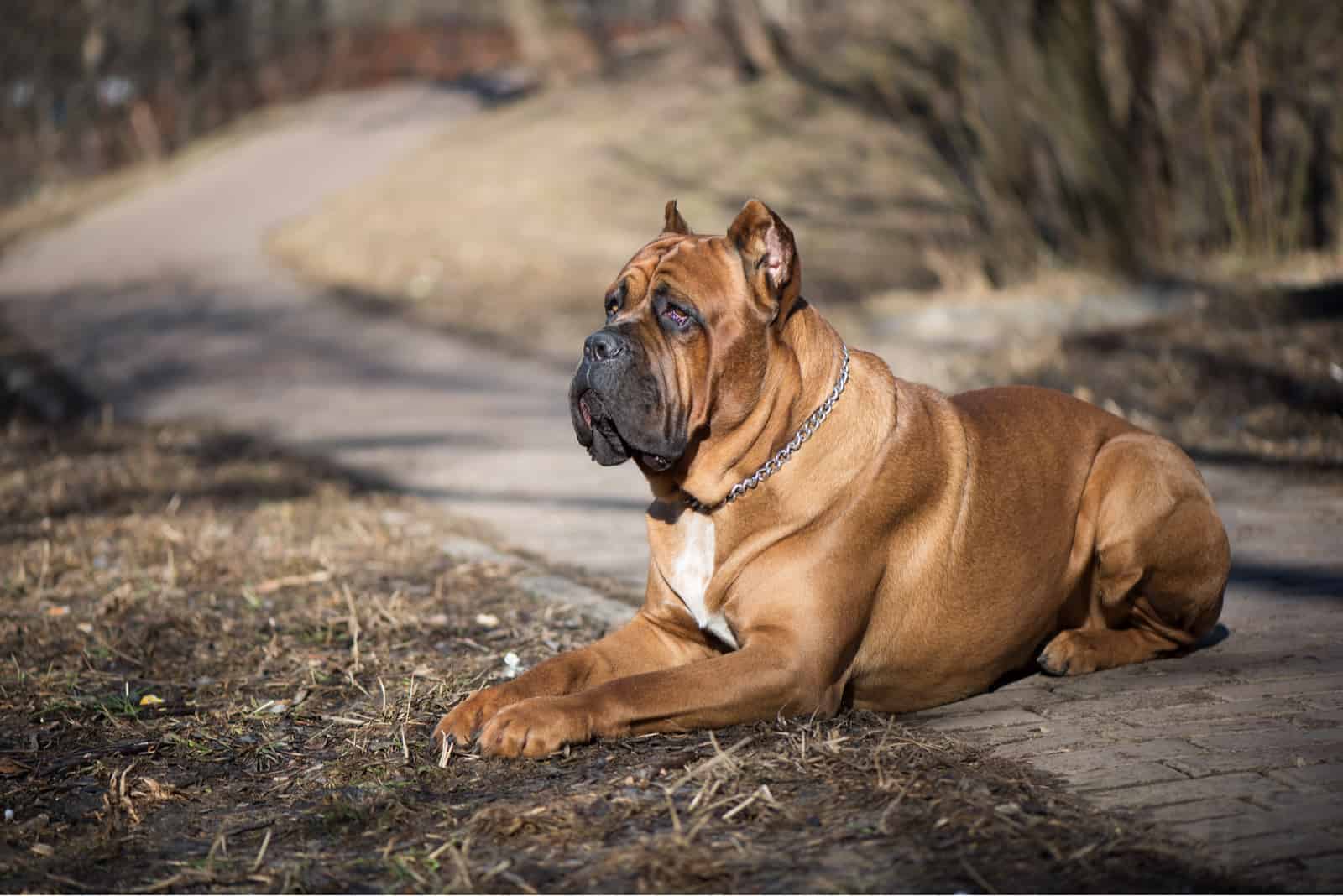
Don’t be confused – this dog goes by both names.
Its Italian name (pronounced KAH-nay COR-so, by the way) is a big clue to this breed’s nature and origins as it basically means Guardian Dog. This suits it perfectly, as it makes the perfect guard dog.
These big dogs are related to the massive Roman war dogs of old, which were a type of Mastiff of the Molossus breed from ancient Greece.
The older version of the Cane Corso was believed to be much bigger and bulkier. They were also bred to be absolutely fearless and were given the unenviable task of charging enemy lines with flaming barrels of oil fixed to them!
The fall of the Roman Empire ushered in better times for Cane Corsi as they found roles on the thousands of farms across Italy. They were used for livestock droving and herding. They helped hunt boar, and they found their forte as guard dogs, watching over farmsteads, enclosures, and hen houses.
Increased mechanization of agriculture brought about a decline in Cane Corso numbers, and they were only saved from extinction by a group of enthusiasts. It wasn’t until the late 1980s that this beautiful breed made it to America, and they were only accepted by the AKC as recently as 2010.
They are considered large dogs, with males measuring between 25 and 27.5 inches at the shoulder. Females are slightly smaller, between 23.5 and 26 inches, but that’s still pretty big!
As for their weight, the American Kennel Club (AKC) states that it is ‘proportionate to height,’ which is a bit vague. However, records show that they can weigh between 88 and 120 pounds, with males being heavier than females, as you’d expect.
Their size alone can be intimidating, but when added to their alert expression and confident stance, they give the overall impression that this isn’t a dog you want to mess with!
One feature that often sharpens this sense of simmering aggression is the practice of ear-cropping. This is a surgical procedure that removes a section of the ear (or the whole ear, in some cases) to make them smaller and pointed, providing a look of permanent alertness.
It’s a controversial procedure that is entirely unnecessary and painful for the animal. The only reason for this practice (the same applies to tail docking) is to adhere to breed standards set by organizations like the AKC.
Ear cropping offers zero practical benefits to the dog whatsoever, despite what you may read elsewhere. This cruel, pointless practice has been outlawed in many countries and states in America, although, in some states, it is regulated.
The Cane Corso dog has a short, dense, double-coat that needs brushing at least once a week. The undercoat will vary depending on the local climate, but it sheds moderately all year and a lot during the shedding seasons in spring and fall. At these times, you’ll need to brush them every day, or you’ll be knee-deep in dog hair!
This coat can be gray, black, red, fawn, gray brindle, black brindle, or chestnut brindle, with a black or gray mask.
Now that we know more, let’s look at its temperament!
Are Cane Corso Considered An Aggressive Breed?
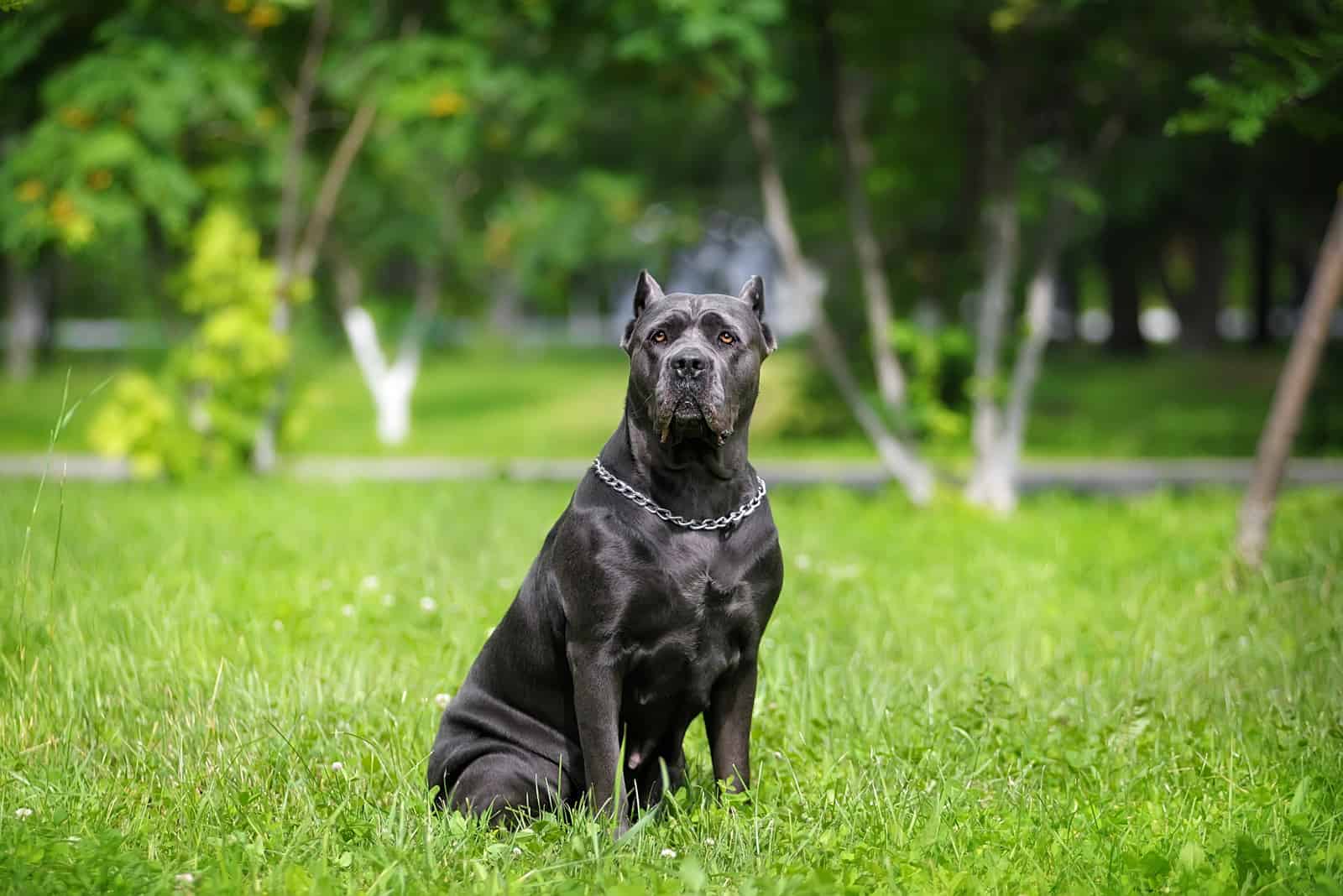
It depends on what you mean by aggressive.
Yes, they can be territorial, and they have a high prey drive. They’ll protect what’s theirs, including your home and family members. They can also be aggressive towards other dogs and have been known to chase them down. Injuries are common in these cases, and some attacks have even been fatal.
Even so, these dogs are generally calm and placid. They are affectionate with family and good with children, especially when raised in the same home.
So, what causes the problem, and how do you fix it?
First, we have to look at the involvement of humans. Some people just aren’t compatible with certain breeds. The Cane Corso needs a confident, assertive owner who will be firm at all times. This dog needs to know that you are in charge, or they’re likely to take over your home. Once they assume the role of alpha, they’ll be difficult to handle, interpreting your attempts to control it as a challenge to its authority.
Also, you need to understand the dog and be familiar with its body language (another reason why ear-cropping is bad, as the position of a dog’s ears can say a lot!) so you can adjust your response.
Then there’s the question of dog training. All dogs need to be trained to an extent, but with intelligent, powerful dogs, the need is even greater. This must start at an early age, and should be extensive, not just limited to a handful of commands. Your dog really needs to understand that you mean business. When you say stop, it must stop, no question.
If this isn’t something you can commit to, then you are not a suitable owner.
Finally, and equally as important as training, is early socialization.
Regular, intensive, consistent socialization will get your Cane Corso puppy used to other dogs and humans. They’ll start to be more accepting of them and much less likely to display aggression.
As a dog owner, it’s your responsibility to ensure that they are safe and don’t present a danger to the public, yourself, or your family. All dogs can be aggressive under certain circumstances. Bigger dogs tend to get a bad rap because their bites cause more damage. It’s up to us all to reduce the chances of attacks and injuries by training our dogs, getting them well socialized, and keeping them in check.
The Bulldog
We run into a bit of difficulty here because there isn’t just one single breed called ‘the Bulldog’! This might affect the outcome of any mixed breed, so it’s important to make sure that we pick the right one.
To get around this problem, we’ll list a few of the more well-known types of Bulldog, then take a look at what a mix between these and the Cane Corso might be like:
American Bulldog
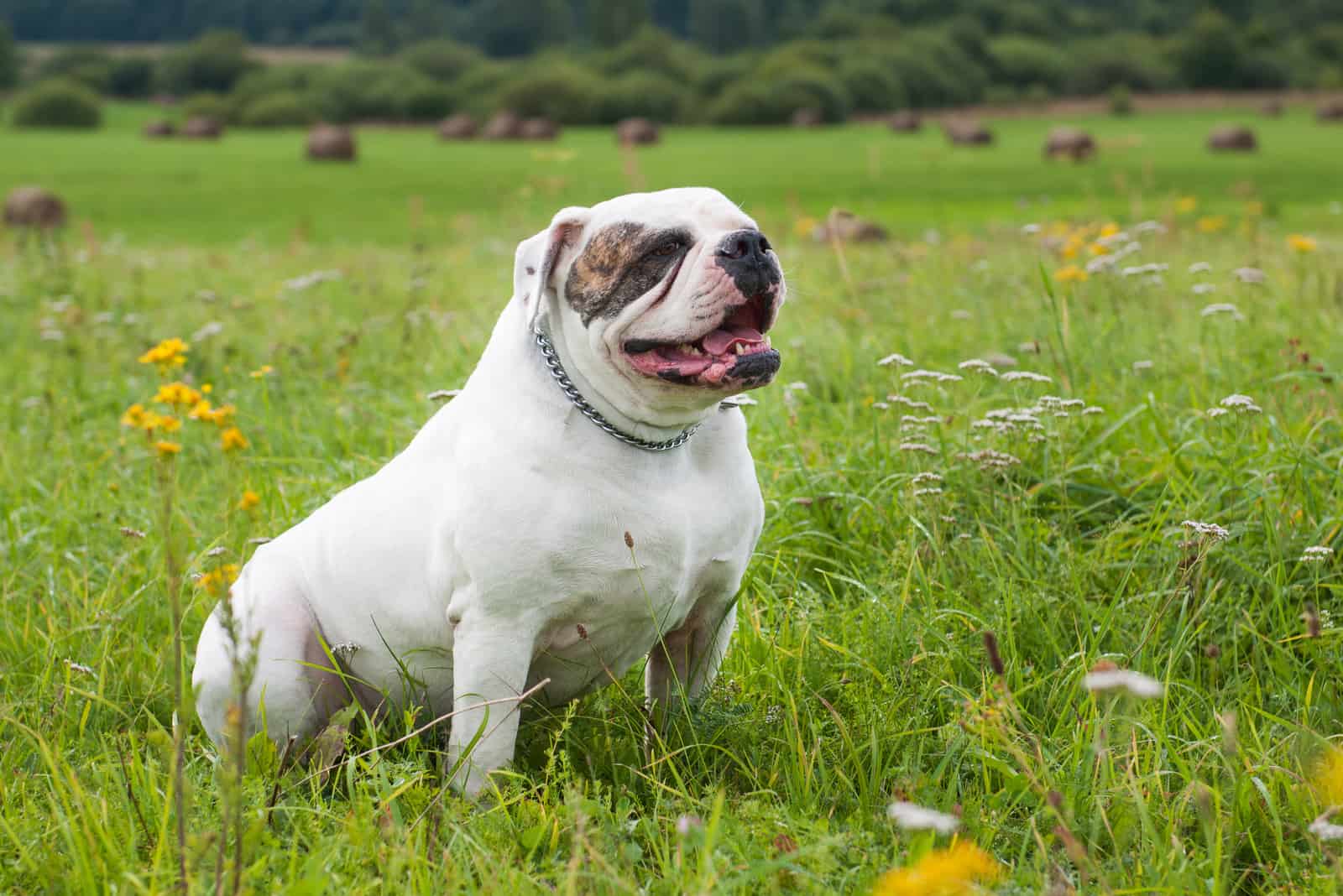
The American Bulldog was developed from the English variety after being transported across to the US by immigrants who introduced them to farms across the country. They tend to be bigger and healthier than their cousins across the pond, and they are much more agile and athletic.
Despite their size, they are generally gentle, friendly, affectionate, and playful. They have a higher energy level than their smaller relatives and like to be kept active. Oh, and they’re pretty smart, too, so they’ll need some mental challenges to keep them happy.
• Weight – 60 to 120 pounds.
• Height – 20 to 28 inches.
• Color – white and black, solid black, solid white, chocolate, blue, lilac, white and tan, white and brindle, and white and brown.
• Lifespan – 10 to 15 years.
French Bulldog
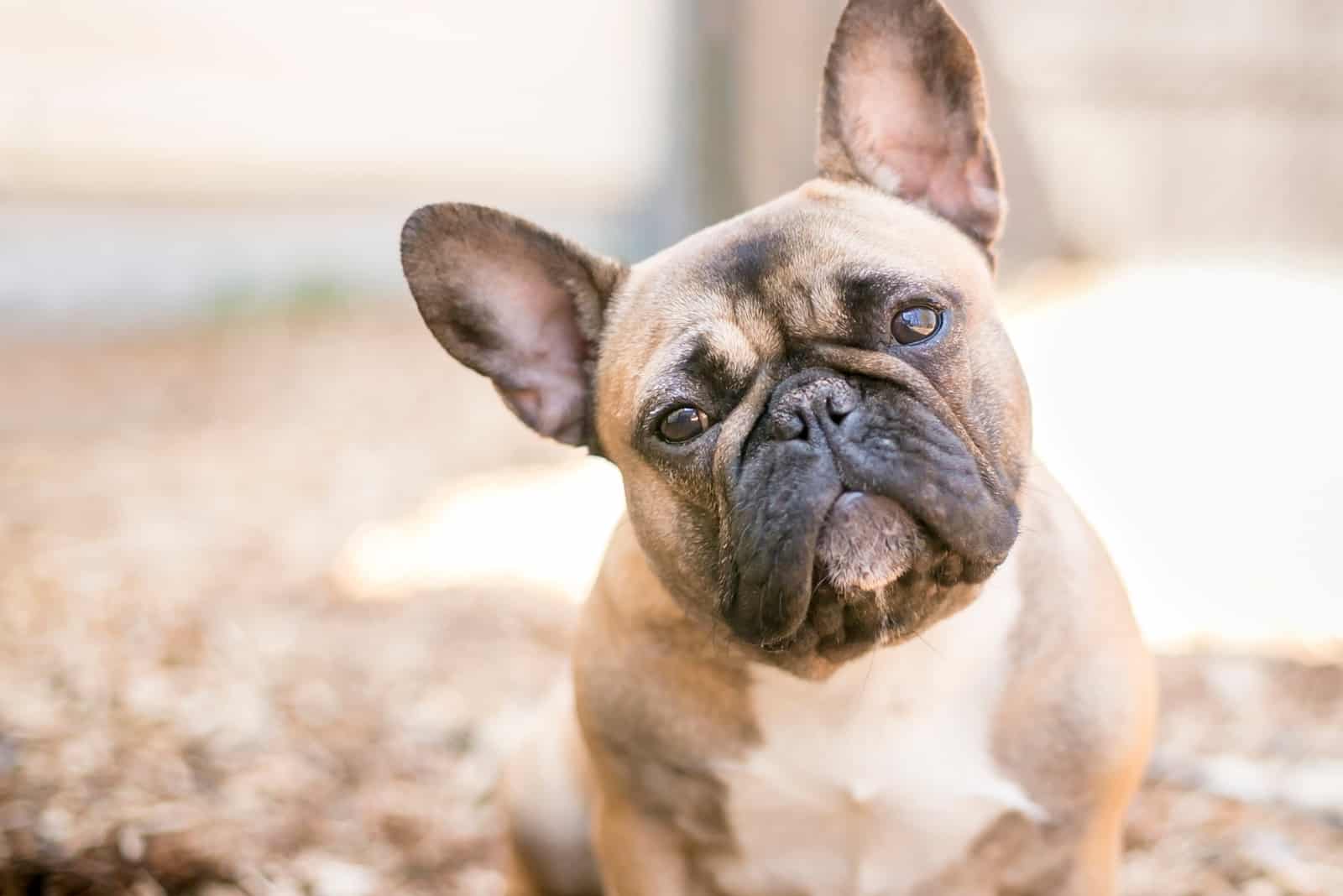
This little dog is a joy to have around. It loves you, your family, and most other people. It’s pretty well behaved around other dogs too. It adapts well to many different situations and fits into your lifestyle without too much fuss.
The French Bulldog also wants to play all day long. Everything is a game to this dog until it wears itself out and just wants to curl up beside you on the sofa.
Just because he’s a bit of a clown, don’t think that he’s not smart! This dog will need some mental stimulation to keep him from becoming restless.
He’s easy to groom – a weekly brush will be fine.
• Weight – less than 28 pounds.
• Height – 11 to 13 inches.
• Color – brindle, brindle and white, tan, fawn, and white.
• Lifespan – 10 to 12 years.
Olde English Bulldogge
This name is a bit misleading as the breed was created in the late 1970s as a project designed to revive the size and form of the original Bulldogs of Regency England.
The true Old English Bulldog became extinct during the early 1900s, around seventy years after the cruel sport of bull-baiting was outlawed. Bulldogs took their name from this blood sport, where these dogs were set on tethered bulls, and wagers were placed on which one would bring the bull down or die in the attempt.
The Olde English Bulldogge looks as close as you can get (from descriptions and paintings) to the original but has deliberately been made placid, playful, and affectionate. Despite its robust ruggedness and muscular features, it’s a big softy!
• Weight – 60 to 80 pounds.
• Height – 17 to 20 inches.
• Color – solid/pied red, black, fawn, or white. Brindle fawn, red, or black.
• Lifespan – 9 to 14 years.
English Bulldog
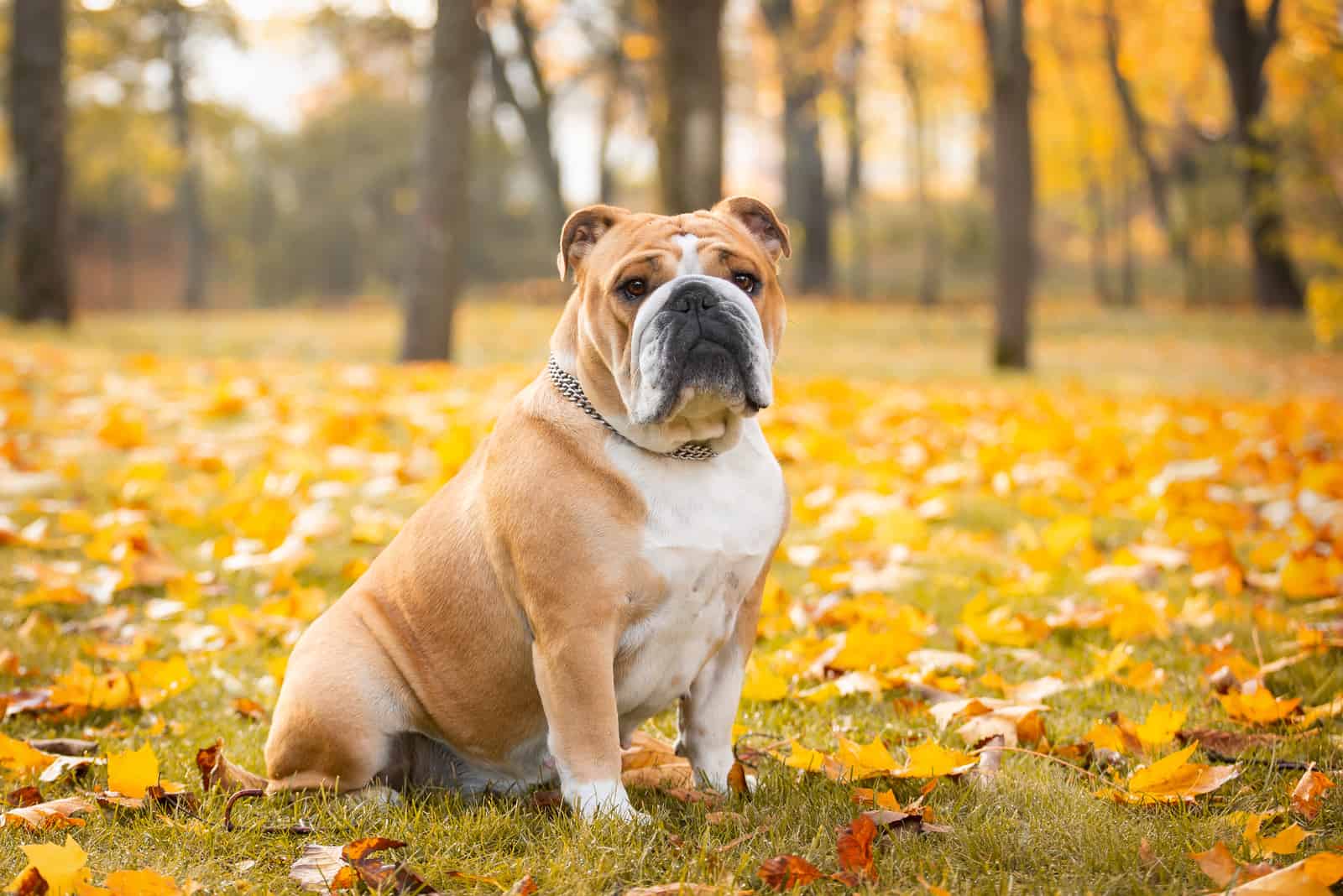
Remember, this isn’t the ‘old’ English Bulldog, as they are no more.
This breed is also called the British Bulldog, or simply Bulldog, which causes confusion at times.
Despite its fearsome-looking appearance, it’s a gentle-natured creature. It is sweet and affectionate, especially with kids, making it an excellent family dog.
English Bulldogs are people-oriented and will constantly seek out human company. They don’t much like being left alone and may misbehave if you leave them for too long. They thrive in temperate climates and don’t need a lot of exercise.
Overheating can be a real problem because of their short muzzles. They don’t do well in water either, so it’s not a good idea to take them swimming. Their short legs can’t propel them, and they struggle to breathe because their nostrils and airways are restricted.
• Weight – 40 to 55 pounds.
• Height – 14 to 16 inches.
• Color – red, red brindle, fawn, white, fawn and white, brindle and white, red and white, and piebald.
• Lifespan – 8 to 10 years.
Right, now that we’ve looked at some types of Bulldogs (there are others, but most of them are so rare that few people will have heard of them!), we’ll explore some of the Cane Corso Bulldog mix breeds.
But first, a question that gets asked quite a lot…
Is An American Bulldog Considered An Aggressive Breed?

We could lift the section on Cane Corso aggression and paste it here!
Dog aggression is a sensitive subject, with a lot of prejudice and misunderstandings. For example, take the Cane Corso Pitbull mix. Some readers will immediately imagine this to be an aggressive dog. However, ask a Pit Corso owner about their pooch, and they’ll tell you that it’s the sweetest, softest teddy bear you could meet!
So, let’s see if we can find some balance.
The American Bulldog has a reputation for being aggressive, based mainly on its looks. Its powerful, muscular body is low to the ground, with a stance that suggests that it is ready to attack. It has a wide, flat head with sagging skin that makes its expression hard to read. It has a deep, menacing bark and big teeth that protrude from its jutting lower jaw.
The thing is, these dogs rarely attack without provocation. Even so, once that provocation is there, the American Bulldog is not one to back down!
So, what kind of thing provokes this action? Like so many other breeds, they love their family and assume the role of protector. If they perceive a threat, they will challenge it.
Aggression is caused by many different factors. Sometimes it’s not aggression at all but defensive behavior or a reaction to pain, fear, or anxiety.
In the majority of cases, real aggression can be resolved through training, love, patience, and care.
Cane Corso American Bulldog Mix

Photo from: @olliesarkpetcare
This will be the largest Bulldog Cane Corso mix. Both breeds are big, and in some cases, the American Bulldog will be bigger than the Cane Corso!
It’s safe to say that you’ll need plenty of space if you get this dog.
She will be affectionate to all family members and will hate being left alone. If you leave her at home for too long, you might come home to find the place has been trashed. And dogs this size can cause quite a bit of damage! To avoid this, if you need to leave her at home for a few hours by herself, make sure she’s had a good run beforehand to wear her out. Give her some puzzle toys or a KONG filled with treats to keep her busy. Ideally, get someone to drop by and make a fuss of her.
This is a high-energy dog that needs a lot of exercise, as well as mental stimulation. She wants to be kept busy all the time and loves to join you on your morning jog or weekend hike.
The Cane Corso Bulldog mix is one healthy dog with a lifespan of around 15 years!
Although she is good with kids, it’s best to supervise any interaction simply because of her size. Also, kids need to be taught how to act around dogs, regardless of size.
She’ll make an excellent watchdog and will make it her priority to keep you safe. This can escalate into aggression at times. While you don’t want to eliminate her guarding instincts completely (it’s always good to have someone watching your back!), you can reduce any risk of real aggression through proper socialization.
All in all, this is a big dog with a big heart. She needs a firm hand and isn’t a good choice for novice dog owners. But for the right family, she’s the perfect pet.
It’s time to do some shopping for your Cane Corso Bulldog mix. Checking our list of high-quality is your first step.
| Food: Purina One SmartBlend Formula | Check Price |
| Bed: FurHaven Ultra Plush Lounger | Check Price |
| Brush: Safari Bamboo Bristle Brush | Check Price |
| Collar: Frisco Monster Bash Collar | Check Price |
| Harness: Chai’s Choice Premium | Check Price |
| Leash: Flexi Comfort Tape Leash | Check Price |
Cane Corso English Bulldog Mix
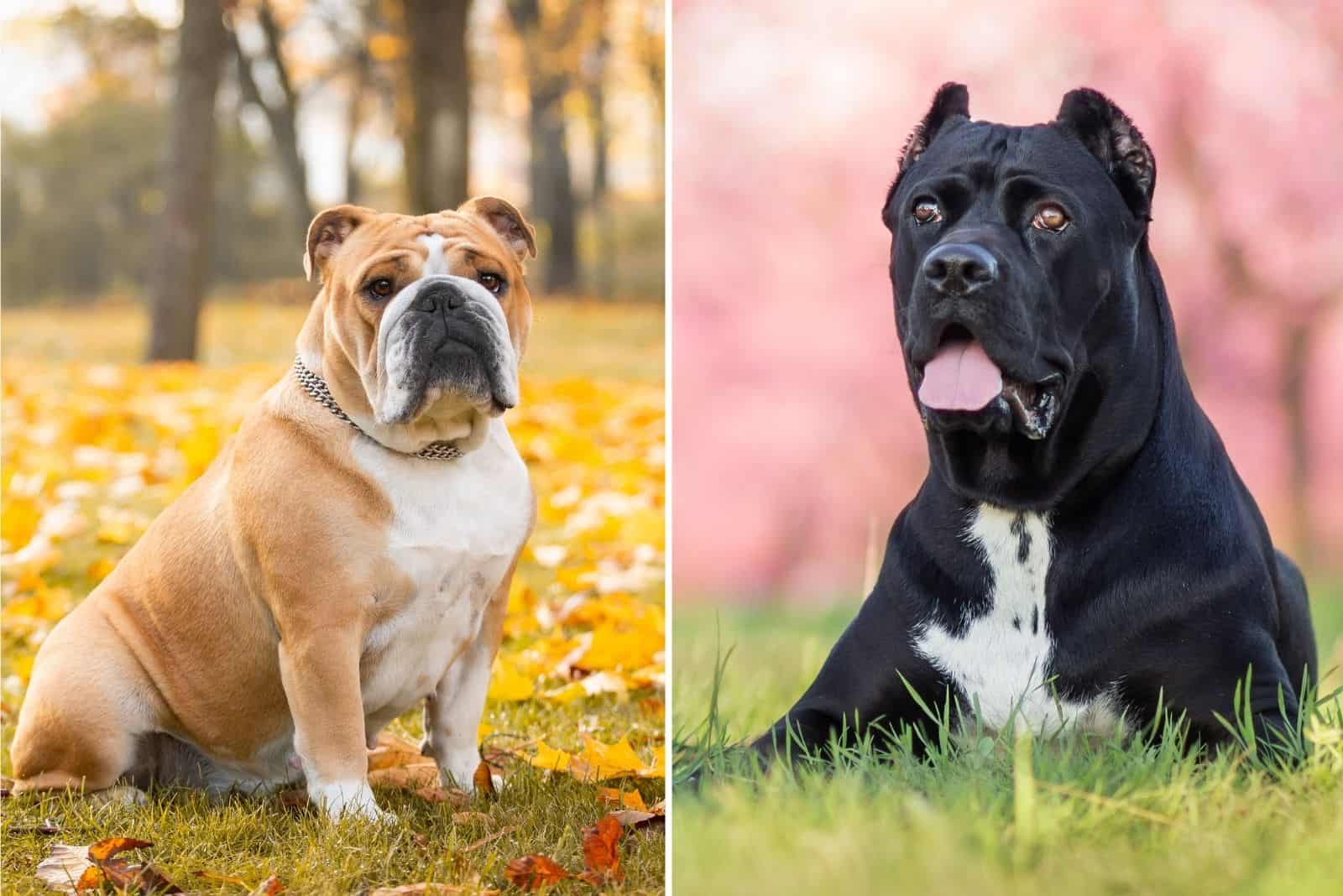
This mix is going to melt your heart with his sweet nature.
He’ll stick by your side and will be loyal to the last. Nothing is more important to him than making you happy, which makes training him an easy task.
Although he has a lot of energy, he might start to flag if you push him too hard. A steady walk and playtime in the dog park or yard should be enough to use up that energy.
As for his size, you should expect him to weigh in at around 50 or 60 pounds and measure up to 18 inches at the shoulder.
There’s a good chance that he won’t take his size into account and will try to settle down on your lap.
Although he’s always alert and watchful, ever-protective of the family he loves, he should be okay with the presence of strangers and other dogs. Socialization is still recommended to reinforce this quality.
Cane Corso French Bulldog Mix
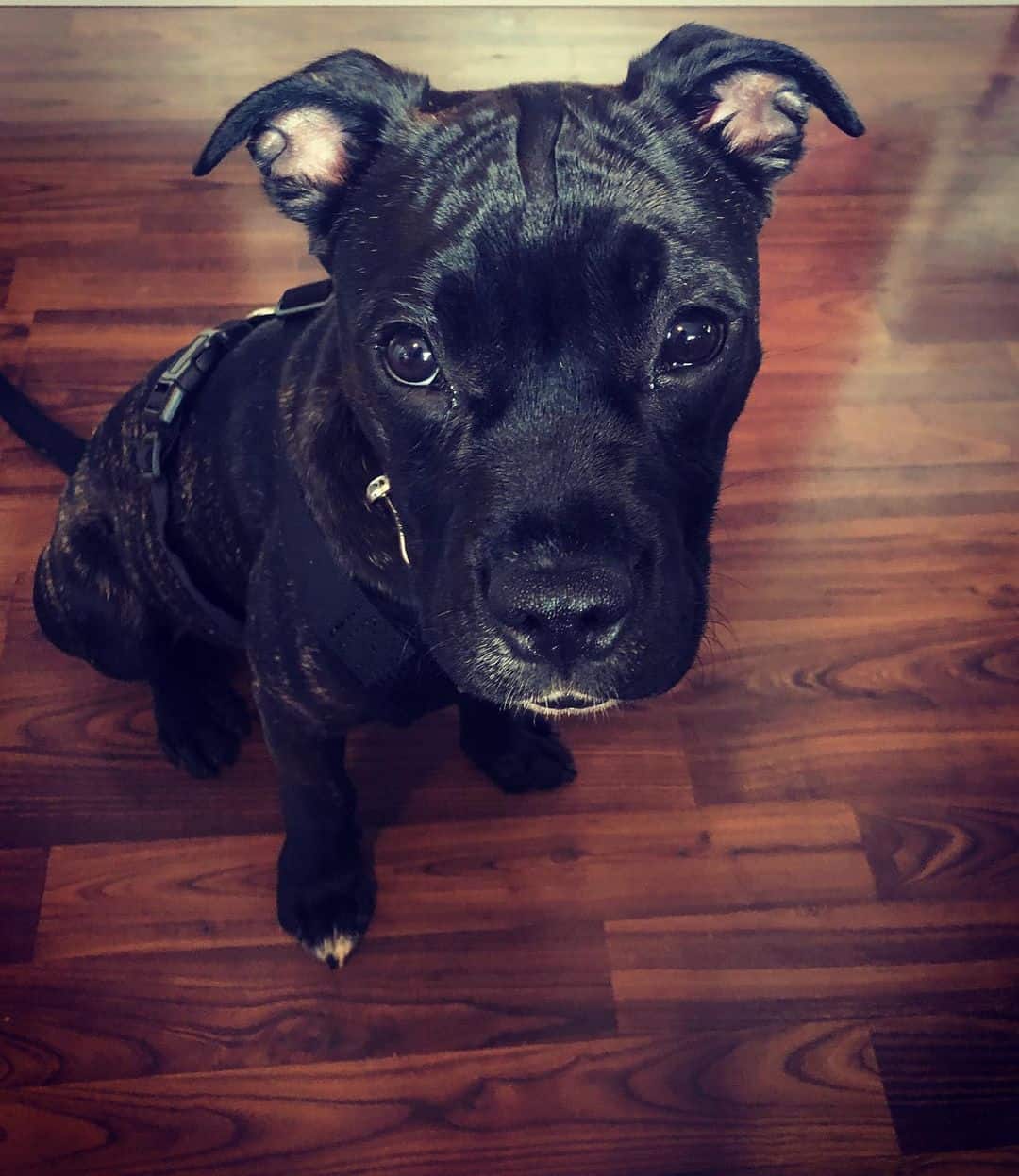
Photo from: @jaci_le_fleur
There’s so little information on this one that it’s almost impossible to give a reasonable overview of what it’s like!
Suffice to say, it is one extremely cute pup.
Also, it is probably going to be much smaller than the Cane Corso parent, but it will probably still be twice the size of the French Bulldog. This raises some ethical questions as to whether breeding dogs of extreme sizes is the right thing to do.
In the wrong hands, an experiment like this could be fatal. For example, if a male Cane Corso is bred with a female French Bulldog (which rarely gives birth naturally anyway), then she will need to deliver by C-section. The pups will be too big and become lodged in the birth canal, which could kill both them and the mother.
This dog’s temperament may be unpredictable too. The French Bulldog is laid-back and affectionate, while the Cane Corso is athletic and eager. Both are intelligent and will need adequate mental stimulation.
As for whether this will be a popular breed in the future, only time will tell.
Cane Corso Old English Bulldog Mix
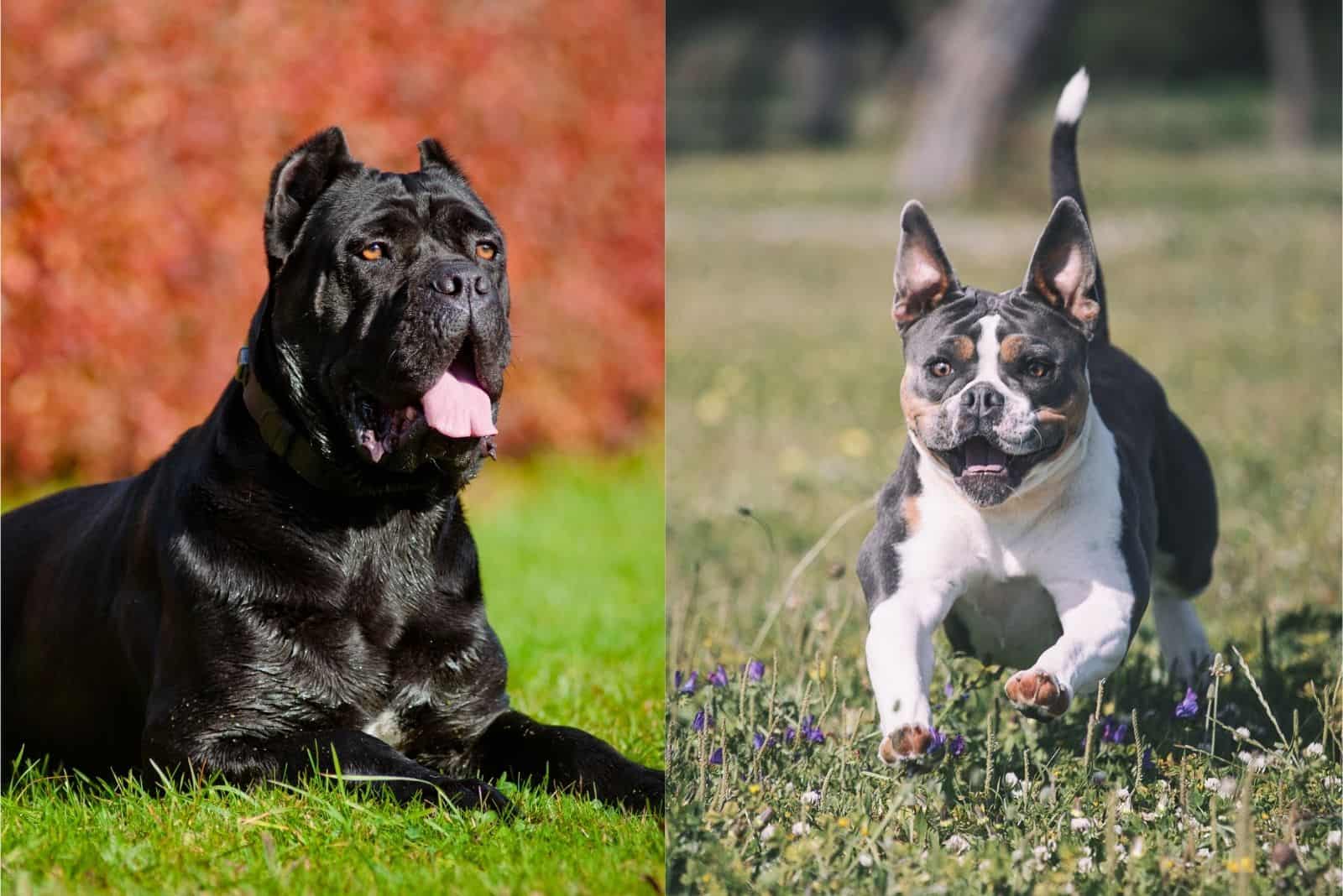
Well, this one isn’t actually possible unless the breeder has a time machine!
As we said a couple of times, the true Old English Bulldog is extinct. Anyone looking for one of these is either unaware of this fact, or they are mistaking it for the Olde English Bulldogge or the English Bulldog!
So let’s move on.
Olde English Bulldog Cane Corso Mix
Actually, it’s the Olde English Bulldogge, but as spellings vary, we thought we’d use this title to make that point.
This is another softy, with bags of affection. Of course, this can be balanced out by the Cane Corso genes, but in general, these dogs will be cuddly.
He’ll have minimal exercise needs and will enjoy a snooze during the day. However, exercise is still important to avoid excess weight gain. A couple of brisk walks a day and playtime around the yard or the park will suffice.
There’s a chance that he’ll be stubborn at times, so you’ll need to have some patience when you begin training, but he’ll soon come around, especially if you use positive reinforcement.
This dog can be highly excitable, which can get out of hand. Training is a good way to get him to calm down.
Ultimately, he’s a loyal dog who just wants to please you.
Health Problems To Look Out For
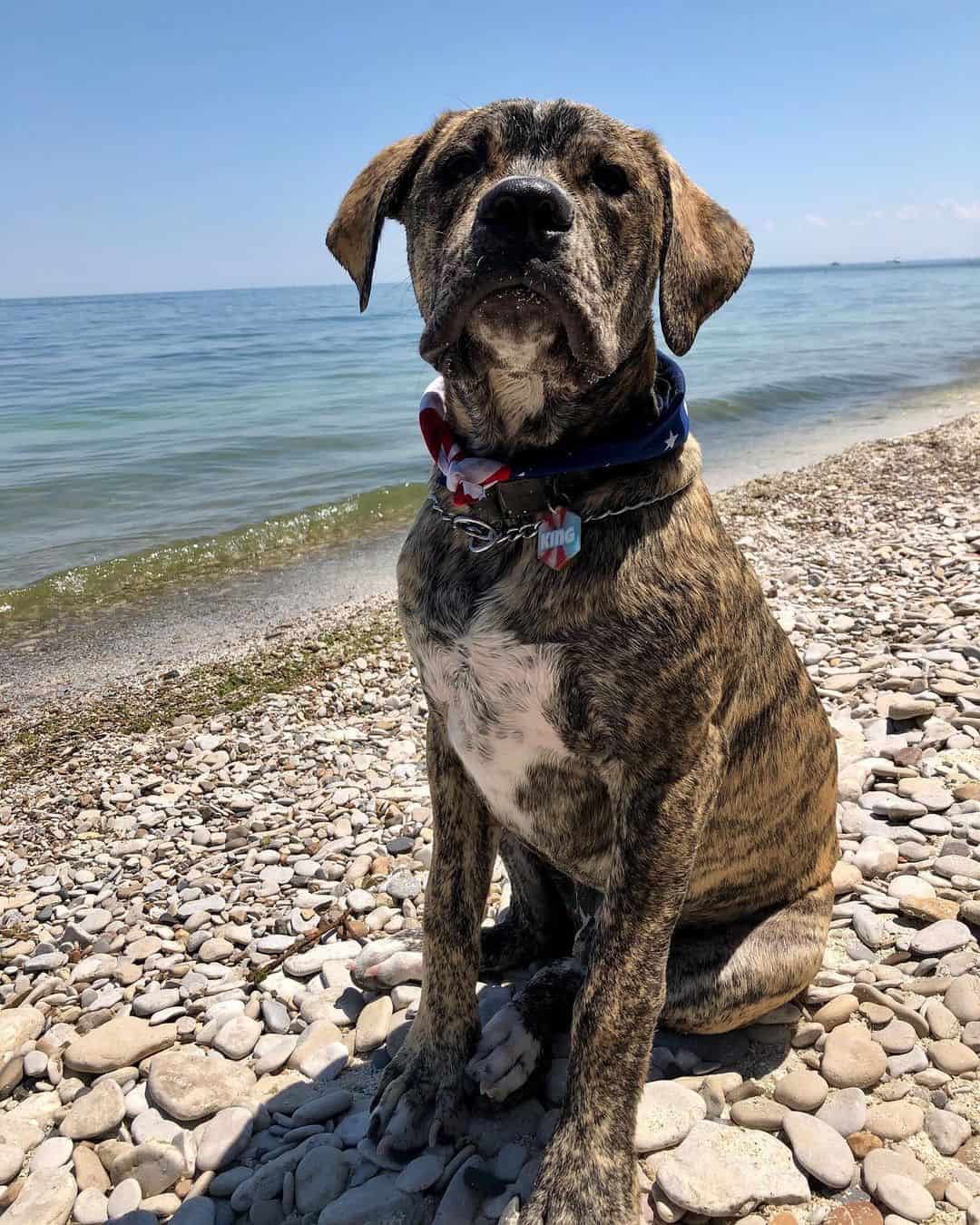
Photo from: @kingandky
The Cane Corso is a pretty healthy breed compared to most others. On the other hand, the Bulldog is known to suffer more health problems than many other breeds. So what can we expect from a mix of the two?
Here are some of the health conditions that could be passed on to the Cane Corso Bulldog mix pups:
• Hip dysplasia – a malformed hip that causes pain when walking. Severe cases need surgery, and the condition causes arthritis in old age.
• Cherry eye – a prolapsed tear gland in the third eyelid. It isn’t painful but looks unsightly and can become inflamed if the dog scratches at it.
• Bloat – a potentially fatal condition where the stomach swells with gas or sometimes liquid. It begins to twist around, stopping blood from getting to vital organs.
• Cancer – Bulldogs (and English Bulldogs in particular) are more prone to cancer than any other breed. It’s still too early to tell whether this has been passed onto any Bulldog Cane Corso mix. All we can do is hope that the wider gene pool will reduce the chances significantly.
• Patellar luxation – a painful condition that causes the kneecap to dislocate.
• Heart problems – once again, this is a common problem in Bulldogs.
• Respiratory problems – this is related to brachycephalism, meaning that the dog has a short muzzle and wide, flat face. Bulldogs, Pugs, Shih Tzus, and many other brachycephalic breeds sometimes struggle to breathe because of the shape of their heads, which restricts the airways.
• Dental problems – the shape of their skulls and jaw sometimes results in teeth being cramped together painfully or missing completely.
Mixed breed dogs are considered healthier than purebred dogs in many cases. This is because purebred dog parents often carry faulty genes that are passed onto the pups. When two different breeds are mixed, there’s a fair chance that some of these genetic faults won’t be passed on.
Anyone who disagrees with this really isn’t paying attention. Take a look at the list of health problems in any purebred dog breed, and you’ll see many of the same ones. These have passed through generations of dogs because breed standards state that they must look a particular way, despite the best efforts of reputable breeders to eradicate them. All it takes is an injection of fresh genes, and a problem could be solved.
A case in point is the English Bulldog, which has more health issues than most other breeds, simply because it is bred to have a flat face and short legs.
In the interests of balance, it’s only fair to say that hybrid dogs aren’t always healthy. Much depends on the actual breed, as well as the knowledge and experience of the breeder!
Is This The Right Dog For You?

Photo from: @jazz_berlino
More accurately, this should read, Is one of these dogs the right one for you? As each different mix offers its own unique benefits and challenges.
But if we look at them in general, taking into account that they all have the Cane Corso genes, then we can say…
If you’re a first-time dog owner, then perhaps not.
If you’re not an active person, or your family would rather spend time chilling at home than hiking through the hills, then once again, perhaps the answer is no (although a couple of these mixes aren’t as active as others).
And if you are shy and retiring, with a passive or placid personality, preferring to let others take the lead, then this is not the best dog to choose!
The Cane Corso Bulldog mix, especially if it’s a cross with the English or American Bulldog, is a confident dog that needs a confident owner. You must keep the upper hand at all times and set boundaries very early on.
Dog training should begin the moment you get them home. You can start by teaching them simple command words, progressing to dog obedience classes later. This step isn’t negotiable: you must commit to training your dog.
Grooming is important, whatever the breed. Brushing your dog regularly keeps their coat healthy and stops the hair from sticking to your furniture.
All of these mixed-breed dogs will have wrinkles and skin folds that need cleaning to avoid skin infections. Their ears and eyes need to be checked and their nails clipped.
They need high-quality dog food and the right amount of exercise to maintain a healthy weight. Human foods such as durian, scallops, plantains, figs, and brussels sprouts can help boost your dog’s immune and digestive systems.
Finally, most of these dogs will be big droolers. Can’t cope with this? Then it’s not the dog for you!
In the end, these dogs would be better for experienced dog owners. Owning a dog is a privilege and carries an enormous amount of responsibility. The Cane Corso Bulldog mix deserves as much love, respect, and care as any dog, purebred or mixed.
If you understand all this and think you fit the criteria, then you might be the right match for one of these wonderful animals.















